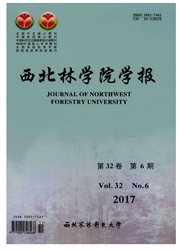

 中文摘要:
中文摘要:
为了选取最优的黄土丘陵半干旱区密植人工枣林细根空间分布的统计模型,以4、8及11年生的密植枣林为研究对象,采用壕沟剖面法获取根系分布的数据,通过选取不同的固定效应、随机效应及协变量(树龄、土层深度、离树干的水平距离),用固定效应方差分析模型、混合效应方差分析模型及协方差分析模型对细根空间分布进行比较分析。结果表明:把树龄作为固定效应、土层深度作为协变量、离树干的水平距离作为随机效应配合的协方差分析模型,修正复相关系数最高,剩余均方差最小;枣林细根随树龄增加显著增加,随土层深度的增加显著减少,随离树干的水平距离无显著差异,符合密植枣林的实际空间分布规律,是最优统计模型。可为准确分析根系空间分布规律提供基础数据,为其他林分的根系空间分布规律的分析提供参考。
 英文摘要:
英文摘要:
In order to establish optimal statistic models to describe the spatial distribution of the fine roots of densely planted artificial jujube plantation,4,8,and 11-year old jujube plantations were selected in the loess hilly semiarid areas as research objects.The root distribution data were collected by the trenches profiles method.Several models were applied and compared,such as the fixed effect variance analysis model,mixed effect variance analysis model and covariance analysis model to analyze root spatial distribution on different fixed effects,random effect and covariant(tree age,soil layer depth,horizontal distance from the trunk).The results showed that the covariance analysis model was the best fitting model which assumed tree age as fixed effect,soil layer depth as covariant,and the distance from trunk as random effect.The corrected correlation coefficient value was the biggest,and the remaining mean variance value was the smallest.The number of fine root increased significantly with tree age,decreased significantly with soil layer depth,there were no significant difference with the horizontal distance from the trunk,it conformed to densely jujube plantation realistic spatial distribution pattern.This result can provide basic data for spatial root distribution characteristics,and theoretical reference for the spatial root distribution of other forest plantations.
 同期刊论文项目
同期刊论文项目
 同项目期刊论文
同项目期刊论文
 Effects of drip irrigation on deep root distribution, rooting depth, and soil water profile of jujub
Effects of drip irrigation on deep root distribution, rooting depth, and soil water profile of jujub 期刊信息
期刊信息
